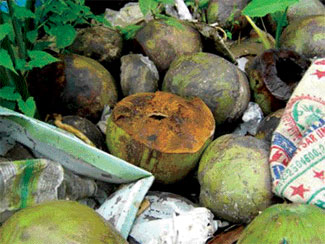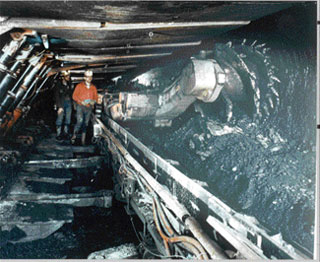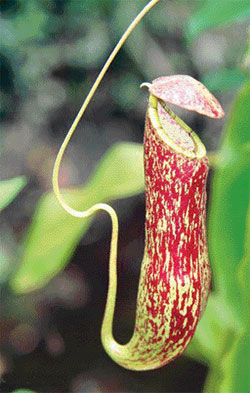How
to minimise road accidents
 Winner: Winner:
t is no secret that the number of road accidents is increasing by
leaps and bounds. Unfortunately, many innocent lives are lost as a
result of this. Who is responsible for these road accidents? In most
instances these accidents are caused due to sheer negligence and
recklessness of people.
 No
one can dispute the fact that many drivers do not observe the highway
code. Drivers should be vigilant and pay attention, especially at
crossings. No
one can dispute the fact that many drivers do not observe the highway
code. Drivers should be vigilant and pay attention, especially at
crossings.
As most drivers do not stop at pedestrian crossings many
people cross the road from various places.
Drunken driving is also a contributory factor for fatal accidents.
People who drive should act with more responsibility and avoid driving
under the influence of liquor.
High speed driving is another major cause
for road accidents in Sri Lanka. Belching vehicles on the road too can
cause road accidents. Some do not possess driving licences although they
drive vehicles.
Those who sit behind a wheel should be very careful, especially on
rainy days because the roads are slippery and the visibility too is
poor. Many people are in the habit of running across roads, unexpedtedly.
How can we minimise the number of road accidents?
The Government should impose strict laws for errant drivers. On the
other hand, pedestrians too should be educated on road rules.
Motorists should also wear seat belts and motor cyclists should wear
helmets when travelling on the road. People should not be permitted to
use mobile phones when driving and riding.There should be discipline on
the road and people should strictly follow road rules. We have to be
patient when using the road and not do anything that could endanger
someoneís life.
Letís determine to be good road users for the safety of the general
public.
Thisari Imesha Akannangara,
Grade 9E,
St. Maryís College, Mathugama.
Stop the spread of
dengue
Winner:
 Dengue
is a viral disease spread by a mosquito. There is no vaccine for dengue.
At present, it has become a major threat to Sri Lanka because every year
a large number of people become victims of this deadly disease. Dengue
is a viral disease spread by a mosquito. There is no vaccine for dengue.
At present, it has become a major threat to Sri Lanka because every year
a large number of people become victims of this deadly disease.
Those who die of dengue are mostly children and therefore the
Government has taken special measures to prevent the spread of dengue in
the country.
Dengue mosquitoes lay eggs in clean water and even a very small
amount of water is sufficient for a dengue mosquito to lay eggs. For
example, even the lid of a tooth paste tube can be the breeding place of
a dengue mosquito.
Dengue spreads widely after the monsoon rains. Therefore, the disease
spreads fast in the wet zone in Sri Lanka as this region gets rain
throughout the year.
The only step we can take to prevent dengue from spreading is to keep
the environment free from mosquito breeding places.Many have died this
year as a result of dengue, so, it is important to keep the environment
free of water collecting receptacles.
L. H. Isuri Arunoda,
Grade 8-1,
Veyangoda Bandaranaike Central College.
The light in the
night

Winner:
On a clear dark night itís a bright flare which flaunts the sky. The
friend of twinkling stars, it gives light to the entire world. It is
brilliant in a silvery colour.
The silvery beams that light up the world beneath at night, attracts
many people to watch the night sky.
The various star patterns around it are mesmerising. This is a
fabulous sight in the night sky.
When poets composed poems they looked at it and were inspired to
write poems more beautifully. Because it is very calm at night and also
gives a sense of serenity and security to humans, I spend long hours
watching the night sky. It gives me great pleasure.
Can you guess what this bright light, the only satelite of Planet
Earth is? Yes, itís the light of lights, the ĎMoon,í shaped like a huge
O.
W. Ishara Madushani Fernando,
Grade 9D,
NW/Ch/Wen/Girlsí College Dankotuwa.
Waste not, want not
Winner:
Water that flows in streams and rivers quench the thirst of both man
and animal. Bauxite mined from the earth is used for industrial
purposes. The water and the Bauxite are precious to humans because they
are needed to fulfill manís necessities. Such sources are defined as
natural resources because they fulfill human necessities as well as
ensure the existence of humans.
 A
gem hidden in the earth has no significant value. But after it is mined
and cut, the gem carries a high value. Similarly, the value of natural
resources that exist in the environment increases through human
intervention. The knowledge, skill and experience that humans possess to
extract and use them add more value to these natural resources. A
gem hidden in the earth has no significant value. But after it is mined
and cut, the gem carries a high value. Similarly, the value of natural
resources that exist in the environment increases through human
intervention. The knowledge, skill and experience that humans possess to
extract and use them add more value to these natural resources.
From the earliest days of civilisation, natural resources were
recognised and used by humans.
Then in the nineteenth century, the Industrial Revolution drastically
changed the role of such natural resources. Large scale utilisation was
needed to fulfil the necessities of the industrial lifestyle. Deposits
of resources such as iron ore and coal were increasingly tracked down
and mined as fuel and raw materials for industries.
This large scale utilisation posed no immediate threat or problem to
humans or the environment, apart from pollution.However, as the years
progressed, humans realised that natural resources do not regenerate at
the same rate at which they are being utilised. While it took only a
matter of hours to cut down full grown trees it took many years for
similar trees to grow back again. During this period of time the
ecological balance of the environment would be lost. Many animals would
lose their habitats while concerns such as soil erosion would mount,
causing in the end, many serious environmental issues.
Humans realised that natural resources were not everlasting but
degenerating, and would one day be gone forever. Today, the world is
dependant on resources such as fossil fuels to generate the energy
needed for the machines and vehicles used around the globe. Without
these resources the mechanised world will grind to a halt by the year
2050, as estimated by experts in the field.
The utilisation of natural resources in a pre-planned methodical
manner can be called the management of natural resources. At present,
steps have been taken towards a better management of natural resources.
In Sri Lanka, the Government issues official permits for activities
such as mining and logging with the view of controlling over utilisation.
There are many other steps that can be taken to manage the use of
natural resources in a better manner than that of the present. Rules and
regulations regarding natural resources can be revised and reinforced
regularly. The general public has to be further informed regarding the
importance and value of natural resources through effective programmes.
It is a duty of humankind to use natural resources intelligently for
the betterment of all beings on the earth. Through a methodical approach
to natural resources, they can be used effectively. Let us remember that
those who do not waste will never want for anything.
Nillasi Liyanage,
Grade 12G1 (Arts),
Musaeus College, Colombo.
Amazing pitcher
plant

Winner:
The pitcher plant which grows in shallow areas where soil is poor in
nitrogen, is an amazing plant. It has large leaves which are twisted to
form a pitch-shaped vessel with a lid. It attracts insects with this
pitcher in which rainwater is accumulated. The inner walls of the
pitcher are lined with fine hairs which are directed downwards. When an
insect, attracted by the water inside, goes into the pitcher, it gets
trapped inside.
However much it would struggle to come out, it has no escape. The
hairs keep it entangled and the insect eventually dies of exhaustion.
Ultimately, the insect is digested and absorbed by the plant.
This is how the amazing pitcher plant catches insects.
Shehani Maheshika Dilini Ekanayake,
Grade 7B,
Girlsí High School,
Kandy.
Annual school trip
A visit to the Victoria hydro-electricity power plant was the annual
educational trip this year. The night before this eventful day, I could
not have a good nightís sleep because I was dreaming about this fun trip
so much. Inspite of the darkness early in the morning, I had to rush to
school with my father because we were asked to report to school before
the scheduled time for the buses to leave. After invoking the blessings
of the Buddha at the school Buddha shrine, we were allowed to take our
seats in the buses. Like a happy band of picnickers, we started the
journey, singing and clapping. When the sun rays began to fall we were
in the country side. We noticed that the bus was not running smoothly
and realised that it was because we were passing the highlands.
 The
teachers had a difficult time trying to keep us quiet as we were not
willing to stop the singing. However, as they emphasised the need for
discipline and behaviour we stopped our singing, once we reached our
destination. In accordance with the rules we had to queue up and walk
towards the high security area. I could not believe my eyes. It is not
just a reservoir but also a magnificent creation. Whatís more, this
awesome creation was surrounded by a picturesque mountain range. The
teachers had a difficult time trying to keep us quiet as we were not
willing to stop the singing. However, as they emphasised the need for
discipline and behaviour we stopped our singing, once we reached our
destination. In accordance with the rules we had to queue up and walk
towards the high security area. I could not believe my eyes. It is not
just a reservoir but also a magnificent creation. Whatís more, this
awesome creation was surrounded by a picturesque mountain range.
We learnt that, about 6000 families who dwelled here were evacuated
and also that the former town of Theldeniya too went underwater during
construction. About 722 million cubic metres of water had been blocked
and stored by a huge concrete dam which is 122 metres in height and 520
metres in length. The water plunges over the dam and falls into the deep
basin in a mist. It was so spectacular that we didnít feel like leaving
the place.
After viewing this great dam, we visited the power plant which
generates 210 mega watts, the highest amount of hydro-electricity in the
country.
The reservoir is located at an elevated landscape and the power plant
is at a lower point. We were allowed to visit the power plant in small
groups.
An official described the hydro power generation process to us. The
sound of the machines and water echoed all over and made the place seem
eerie and strange. Rotating turbines and other machinery could be seen
inside the place and we found it somewhat dangerous. When we came out of
this glorious site, having gathered a lot of knowledge, it was already
evening. So, we started our return journey. On our way back, we visited
the Sri Dalada Maligawa.
With the blessings of the Sacred Tooth Relic we were able to reach
the school at night without any mishaps.
Yasasi Liyanage,
Grade 9-C,
Bidyakara Balika Vidyalaya,
Maharagama.
|

